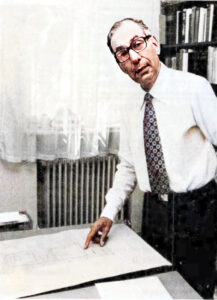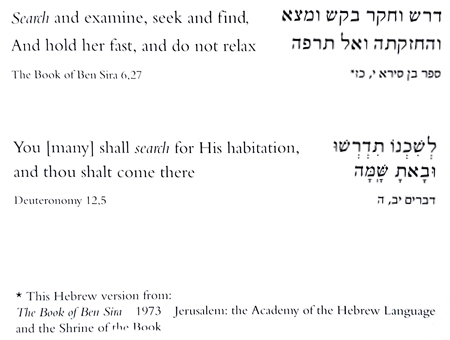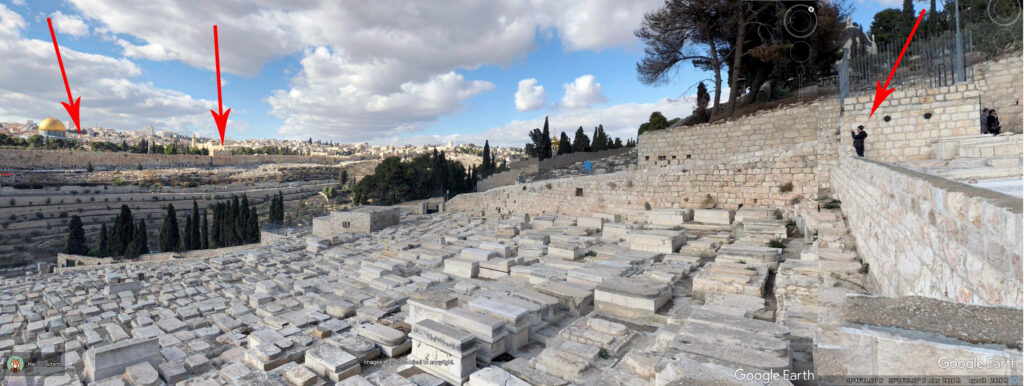Contents

Dr. Kaufman acknowledged God’s hand in his books, writings, and presentations.
“YOU shall seek His habitation, and THOU shalt come there.” Deuteronomy 12:5
Many people have tried to “get there” to find out where the Temple stood—”many” “you” in the plural. But it says “thou” only “one” will get there. Only one will find the real place. I wouldn’t dare to come here if I weren’t sure where the actual location is. I feel I just couldn’t speak to an audience pretending to know where the actual location is.
With great humility, Dr. Kaufman made that bold proclamation at a conference of his peers and others interested in the Temple’s location (see Kaufman Full Lecture, 1993). He was audibly scoffed at (with an expletive masqueraded as a cough), and those colleagues have done their best to shun his work these many years (e.g., Biblical Archaeology Review, Hershel Hanks, Leen Ritmeyer, Chuck Missler, Dolphin Lambert, etc.).
Though Dr. Kaufman’s Temple Mount location was given by “divine providence,” the fine details took 20 disciplines, 200 Temple Mount visits, and years to prove scientifically because archaeological digs were not permitted there. Otherwise, he said it would take a team about 15 minutes to confirm its true location, with a variance of not more than 10 centimeters (yes, “centimeters”).
Kaufman made use of some 20 disciplines, including mathematics, civil engineering, ancient Jewish art (contemporary pictures on coins and other artifacts depicting the Temple), ancient metrology (fixing standards of measurement), airphoto interpretation, comparitive architecture and, of course, extensive reading in Jewish and secular sources, etc.1
Aliyah Article
A final note: Did Divine Providence guide me all that tortuous way to the Temple site? I leave it to you to decide. Whether your answer is yes or no, come and join us in Yerushalayim. (Asher Kaufman>Aliyah)
The book follows chronologically the path of enquiry pursued by Kaufman himself for the past 35 years, leading you up the same blind alleys as he pursued and THROUGH HIS MOMENTS OF INSPIRATION HE MIGHT PREFER TO CALL THEM REVELATION WHERE DIVINE PROVIDENCE HAS GUIDED HIM. (Susan Goodman, “Location, location, location – A physicist puts his mind to the geographical problems of the Temple Mount,” Jerusalem Post, September 26, 2005)
The first two revelations were printed on the first page of his book The Temple Mount, Where is the Holy of Holies, a profound acknowledgment that needed no further explanation, so he gave none.
Revelation 1 – Sira 6:27
“Search and examine, seek and find, And hold her fast, and do not relax” (The Book of Ben Sira 6:27).
We can be assured this scripture was a personal admonition from God of what Professor Kaufman was to do with his time in pursuit of fulfilling his God-given mandate. He was to:
- Search
- Examine
- Seek
- With the promise he would find
- Hold fast, i.e., don’t give up
- Do not relax
Think of that mandate. Would you like God to tell you for the next 40-50 years of your life, you cannot relax; you must pursue and never give up? That was the seriousness and thoroughness with which Professor Kaufman worked, and that’s why he silently put it on the front page of his book. The second revelation is similar.

Revelation 2 – Deuteronomy 12:5
“You [many] shall search for His habitation, and thou [one] shalt come there.” (Deuteronomy 12:5)
The insertions were Asher’s own. In the audio I heard of his 1993 presentation, he began with that verse and briefly elaborated on it, which was a profound and authoritative thing for him to say.
Here is the transcript with my emphasis:
“Duet.12:5 – You [plural] shall seek His habitation and you [singular – ‘thou’] shall come there.’ MANY have come to find the temple location…but only ONE WILL GET THERE [FIND THE TRUE PLACE]. I WOULD NOT COME HERE IF I WAS NOT SURE OF THE REAL LOCATION. I FEEL I JUST COULDN’T SPEAK TO AN AUDIENCE PRETENDING TO KNOW WHERE THE LOCATION IS” (1993 Temple Mount Conference hosted by Chuck Missler).
More about this event and the reaction he received from fellow speakers and attendees can be found in the chapter Detractors below.
Revelation 3 – His Deceased Daughter
Unfortunately, the Kaufmans lost their teenage daughter at the young age of 19. Her name is Rachel Caroline Kaufman (1952-1971), and Professor Kaufman devoted his books to her, along with a picture of when she was 15. She was intimately involved with every stage of her father’s work. We may rightly say that she knew and even knows more than her father did on this subject, for she was gifted with his scientific aptitude and humble disposition, which allowed her to grow in leaps and bounds in Heaven, where she had access to more information.
For the next 44 years of Asher’s life, he was blessed by her constant companionship, which made Rachel 63 years old when they met again after Asher’s Aliyah home. She was no longer the 19-year-old he last knew but a highly educated woman.
In the book that Asher gifted to me, he goes into detail about how he and his wife’s obedience to a Jewish tradition of respecting the dead by reading regularly from the Torah is what rewarded them with an insight that furthered his understanding of where the Temple once stood. In his own words:
“Rachel devoted time each day to reading from the Prophets and Writings of the Bible. My wife and I continued this practice after her death, in keeping with the time-honoured tradition of reading from the ancient Jewish writings in memory of the departed. On the night of Friday (Shabbat) 27 December 1974, we came to Ezekiel 8:16 at the critical moment to link the direction of the Temple axis with the concept of Temple landmarks. This was the dramatic and surprising turn of events in this research on the Temple.” (Kaufman, The Turning-Point in the Temple Research and the Scroll of Prophetic Lessons (Haftarot), 2013, p. viii)
Revelation 4 – Fast of Tevet
“In the year 5735/1974 the Fast of Tevet in the Jewish calendar fell on 24 December. The fast recalls the beginning of the siege of Jerusalem at the time of the First Temple, and in our time a Day of the recital of the Kaddish prayer in memory of the Holocaust victims. Not long afterwards, on the Sunday afternoon of 5 January 1975 [age 49], I sat facing Dr. (later Prof.) Moshe Dothan, at the time Director of the Department of Antiquities. With a tinge of excitement, I informed him that I had discovered where the ancient Temple of Jerusalem stood.
“He listened attentively and his response was ‘very interesting.’ He then invited me to join him for the monthly lecture given in the adjoining lecture theater in the Rockefeller Museum. I somehow declined his invitation and as I paused at the exit of the Museum, my gaze took me to the higher slopes of the Mount of Olives. I had good reason to behold that place and instinctively decided to make my way there by following the road to Jericho and then taking the steep climb to the high ground of the Mount of Olives. There, I joined the road leading to the ancient Jewish cemetery.
“In the wall on the west side of the road, I noticed an open entrance. On passing through it, there lay before me the wide panorama of the eastern Temple area and the Old City of Jerusalem behind. It was a typical winter’s day and strong gusts of westerly wind buffeted me as I stood admiring the magnificent view.
“The massive Golden Gate, the gate in the eastern wall of the Temple area that has been blocked since medieval times, stood before me.

“In Hebrew, it is called the Gates of Mercy, in the plural, because there are twin entrances. I was to read later that the Jewish scholar and first geographer of the Land of Israel, Rabbi Ish Parhi, mentions in his book written in the early fourteenth century, that the citizens of Jerusalem at the time of King Solomon assembled at this place. He added in the same section of his book that the Golden Gate is situated only a bow shot north of the ancient Eastern Gate of Temple times, the Shushan Gate.
“I wanted to know where I stood. A small cupola could be seen behind the Golden Gate. A bearing was taken by positioning myself so that the left (southern) edge of the Golden Gate and the cupola were in line. It would shortly be sunset and time to recite Minha (afternoon prayer). One of the eighteen (now nineteen) benedictions states:
And let our eyes behold Your return in mercy to Zion.
“On concluding my prayer, I departed from the scene filled with a pleasant feeling as if this petition was being fulfilled. That same evening, I poured over a map of Jerusalem. The cupola was identified as the Dome of the Spirits. Eventually, after a long search at home, a book in Hebrew entitled Nofim VeAtarim (Views and Places) offered a description of this dome.
The Dome of the Spirits or of the Tablets…The pillars are set directly on bedrock which had been smoothed somewhat, without flooring, apparently because of the importance attached to it in former times.
“On reading this, I literally jumped from my chair. What follows is a record of the chain of thoughts and events that led to this unexpected start.” (Ibid., pp. 13-14)